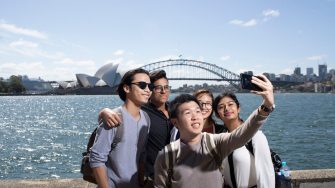
People are so poor at picking good likenesses of their own faces that strangers make better selections, a study by UNSW's Dr David White and colleagues shows.
“In face-to-face encounters with unfamiliar people, it is often necessary to verify that we are who we claim to be," says Dr White, of the UNSW School of Psychology.
"For example, we are asked to prove our identity when processing financial transactions and crossing borders. In these and many other commonplace situations, photo-ID is the most common method for identity verification. However, despite the clear importance of this visual task previous research has shown that we are quite poor when matching photos of unfamiliar faces.”
In the study an initial group of over 130 undergraduate students downloaded 10 suitable photos of themselves from Facebook and ranked them in order of the best to worst likeness. These participants took part in a minute long web cam video of their face and two still photos were also taken (one smiling, one neutral).
Sixteen participants who did not know the students watched the webcam videos and afterwards ranked the Facebook photos in order of resemblance to the person they had seen in the video. A further 73 participants were then recruited to complete an online face matching test.
Results of the study are published in the British Journal of Psychology.
The study found that the unfamiliar participants chose a different set of ‘good likeness’ images compared to those that people had selected of themselves. Surprisingly, the images selected by strangers also led to better performance on the online face matching test. The size of the advantage in other-selection over self-selection was quite large – self-selected images were matched seven per cent less accurately compared to other-selected images.
“It seems counter-intuitive that strangers who saw the photo of someone’s face for less than a minute were more reliable at judging likeness. However, although we live with our own face day-to-day, it appears that knowledge of one’s own appearance comes at a cost. Existing memory representations interfere with our ability to choose images that are good representations or faithfully depict our current appearance," says Dr White.
“Interestingly we also noted there were better results when people were smiling in the photos. It is interesting that current passport guidelines prohibit smiling in photographs because this ‘distorts the normal facial features’. Given that faces are generally pictured smiling, and these images are rated as being more like familiar faces, it may be beneficial to permit expression in passport photographs.”
The research was supported by an Australian Research Council grant and funding from the Australian Passport Office.
Media contact:
Dr David White: david.white@unsw.edu.au
UNSW Science media: Deborah Smith: 9385 7307, 0478 492 060, deborah.smith@unsw.edu.au
